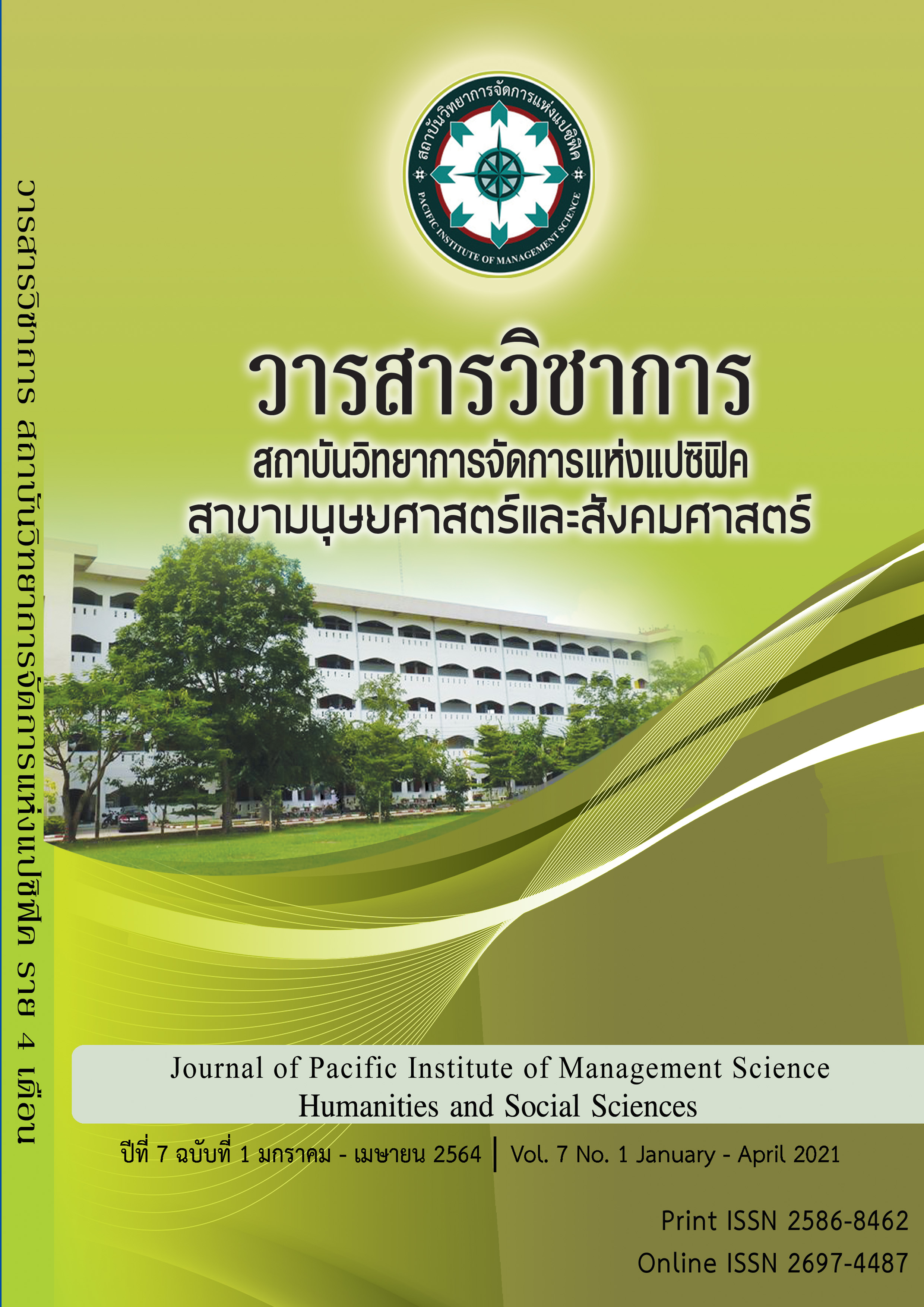Development Explosive Ordnance Disposal of Police Officer for Risk Management Royal Thai Police
Keywords:
Explosive Ordnance Disposal Officers, EOD Officers, Security, Risk ManagementAbstract
This research was conducted using the mixed method research approach with the following purpose: 1) To study problems and risk levels of explosive ordnance disposal (EOD) officers of the Royal Thai Police (RTP). The samples for the case study were 281 EOD officers of the RTP nationwide. The research was divided into two parts. Part 1 was to study and analyze risks and risk management measures of EOD officers of the RTP. Data collection was made by using the questionnaires with the EOD officers of the RTP. The rating scale was divided into 5 levels. The descriptive statistics approach was used in the analysis of general information of the samples. Relationships were analyzed by testing differences of average values. “T-test Dependent” was used for analyzing differences of average values. Hypothesis testing was conducted by using “F-test” values through the analysis of “One Way ANOVA.” Correlation analysis was also used to determine relationships. Part 2 was to study the guidelines for the development of risk management measures for the EOD officers of the RTP. Data collection was made by conducting group conversations with the commissioned and non-commissioned EOD officers of the RTP as well as an in-depth interview with the Deputy Commander of the EOD Division of the RTP.
The study results showed as follows: 1) The problems and the risks of the EOD officers of the RTP were at the highest level; and 2) The guidelines for the development of risk management measures for the EOD officers of the RTP consisted of 4 pillars: (1) Personnel, (2) Work Process, (3) Technology, and (4) Performance Standard.
References
กองกำกับการตำรวจชายแดนที่41.[ออนไลน์]. (2556).ข้อมูลกลุ่มงานเก็บกู้และทำลายวัตถุระเบิด. เข้าถึงได้จาก : http://www.bpp41.go.th/bpp41new/index.
พงศ์กุลธร โรจน์วิรุฬห์. (2552). ความเสี่ยงแนวคิดพื้นฐานและการจัดการ. เพชรเกษมการพิมพ์. จังหวัดนครปฐม.
นิรภัย จันทร์สวัสดิ์.(2551). การบริหารความเสี่ยง. กรุงเทพมหานคร: สำนักพิมพ์สูตรไพศาล.
เมธา สุวรรณสาร.[ออนไลน์]. (2552). การระบุปัจจัยต่างๆที่มีผลต่อองค์กร. เข้าถึงได้จาก : http://www.itgthailand.com.
ยุทธศักดิ์ ไข่ทา.(2561).การพัฒนาประสิทธิภาพการเก็บกู้วัตถุระเบิด ของสำนักงานตำรวจแห่งชาติ กรณีศึกษากลุ่มงานเก็บกู้และตรวจพิสูจน์วัตถุระเบิด กองบังคับการสายตรวจและปฏิบัติการพิเศษ กองบัญชาการตำรวจนครบาล สำนักงานตำรวจแห่งชาติ.โรงเรียนนายร้อยตำรวจ.นครปฐม.
วรรณภรณ์ เติมประยูร. (2544). ความสัมพันธ์ระหว่างบุคลิกภาพ แรงจูงใจใฝ่สัมฤทธิ์และความเครียดกับผลการปฏิบัติงานของพนักงานระดับบริหารชั้นต้น ธนาคารไทยพาณิชย์ (วิทยายานิพนธ์ปริญญามหาบัณฑิต ไม่ได้ตีพิมพ์). มหาวิทยาลัยเกษตรศาสตร์, กรุงเทพฯ.
ศิลปพร ศรีจั่นเพชร, จันทนา สาขากร, และนิพันธ์ เห็นโชคชัยชนะ.(2548). การควบคุมภายในและการตรวจสอบภายใน. กรุงเทพมหานคร: ที พี เอ็น เพรส.
ศศิร์อร ศักดิ์กิตติพงศา.[ออนไลน์]. (2560).แนวคิดหลักของเทคโนโลยี.โรงเรียนพะเยาวิทยาคม. เข้าถึงได้จาก : https://sites.google.com
ศูนย์ข้อมูลวัตถุระเบิด.[ออนไลน์]. (2559).ประวัติหน่วยงานเก็บกู้วัตถุระเบิดสำนักงานตำรวจแห่งชาติ. เข้าถึงได้จาก : http://thaibdc.forensic.police.go.th/?p=884
สมชาย ไตรรัตนภิรมย์.(2549). การบริหารความเสี่ยง. เอกสารประกอบการบรรยาย นครปฐม: มหาวิทยาลัยมหิดล.
สมยศ นาวีการ. (2524). การพัฒนาองค์การและการจูงใจ (พิมพ์ครั้งที่ 2.). กรุงเทพฯ: ดวงกมล.
สมยศ ภวนานนท์. (2537). การบริหารงานความปลอดภัยสมัยใหม่. นนทบุรี: การไฟฟ้าฝ่ายผลิตแห่งประเทศไทย.
สำนักงานคณะกรรมการพัฒนาระบบราชการ.(2551). หมวด 2 การวางแผนเชิงยุทธศาสตร์. กรุงเทพมหานคร: บริษัท วิชั่น พริ้นท์ แอนด์ มีเดีย จำกัด.
สำนักงานส่งกำลังบำรุง. (2560).ข้อมูลจำนวนข้าราชราชการตำรวจ ที่อยู่ในตำแหน่งเจ้าหน้าที่เก็บกู้วัตถุระเบิด. กองสรรพาวุธ.สำนักงานตำรวจแห่งชาติ.
COSO The Committee of Sponsoring Organization of the Tread Way Commission. (2004). Enterprise Risk Management-Integrated Framework-Executive Framework. AICPA, New Jersey.
McClelland, D. C. (1973). Testing for competence rather than for intelligence. American Psychologist, 28(1), 1-14.
Taro Yamane.(1973). Statistics: An Introductory Analysis. 3rdEd.New York. Harper and Row Publications.
Downloads
Published
Issue
Section
License
บทความที่ได้รับการตีพิมพ์เป็นลิขสิทธิ์ของ สถาบันวิทยาการจัดการแห่งแปซิฟิค
ข้อความที่ปรากฏในบทความแต่ละเรื่องในวารสารวิชาการเล่มนี้เป็นความคิดเห็นส่วนตัวของผู้เขียนแต่ละท่านไม่เกี่ยวข้องกับสถาบันวิทยาการจัดการแห่งแปซิฟิค และคณาจารย์ท่านอื่นๆในสถาบันฯ แต่อย่างใด ความรับผิดชอบองค์ประกอบทั้งหมดของบทความแต่ละเรื่องเป็นของผู้เขียนแต่ละท่าน หากมีความผิดพลาดใดๆ ผู้เขียนแต่ละท่านจะรับผิดชอบบทความของตนเองแต่ผู้เดียว







